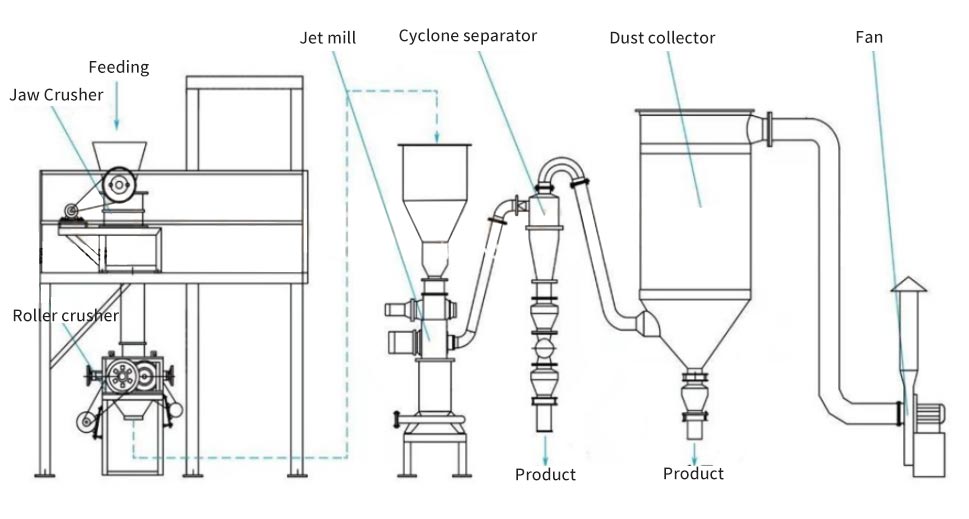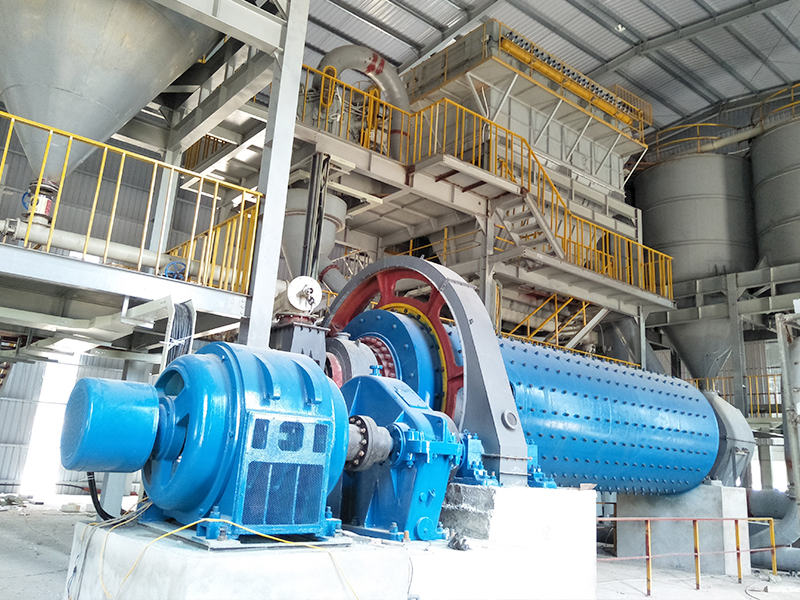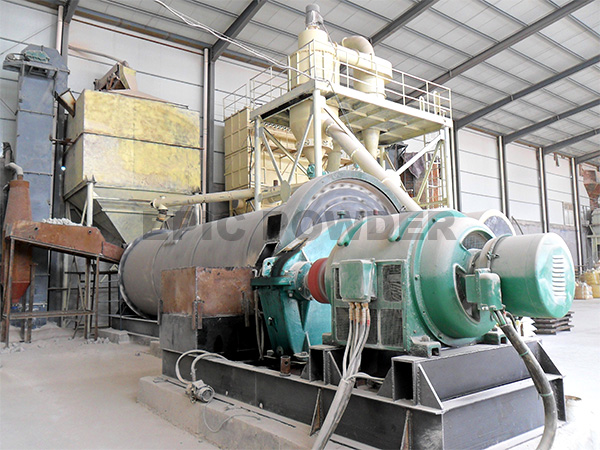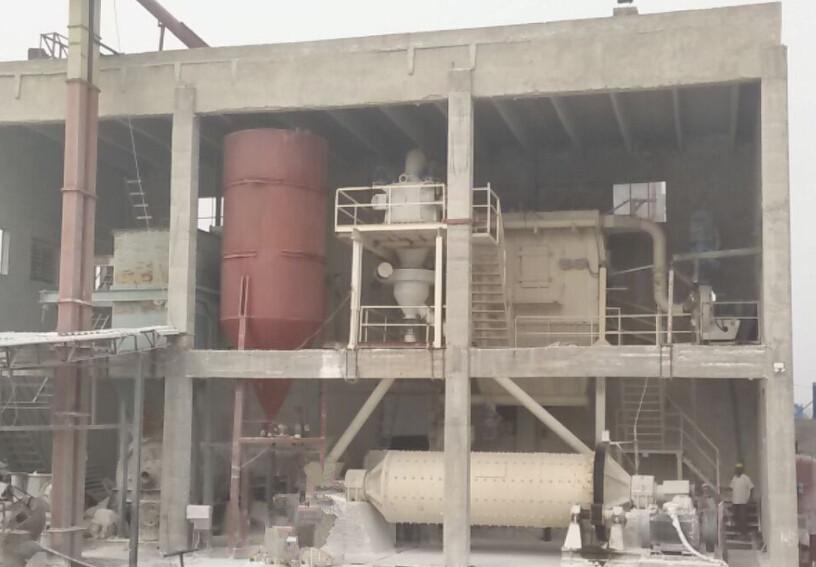NO. 369, Road S209, Huanxiu, Qingdao City, China
Air Classifier Mill,Ternary material,Ternary material grinding

Ternary material grinding process and equipment
The ternary material is a secondary sphere formed by agglomeration of single crystals of about 1μm, and the particle size of the secondary sphere is 3-40μm. The mixture of the ternary material precursor and the lithium source is calcined at a high temperature in a sagger, and there is a burning loss rate of more than 24%, so the material is severely compacted, and it is necessary to use a crushing device to break a few centimeters of large materials into a few millimeters. Small pieces, and then use grinding equipment to grind small pieces of a few millimeters into the final product.
One of the important quality indicators of ternary materials is particle size and particle size distribution. Particle size and particle size distribution will affect the specific surface area, tap density, compaction density, processing performance and point chemical properties of the ternary material. Therefore, the particle size and particle size distribution of ternary materials for lithium-ion batteries must be strictly controlled.
The feed size and product size of different crushing equipment are different, and the compacted ternary materials need to be crushed step by step according to the specific conditions of the equipment. The following table is a comparison of the four commonly used equipment of ternary materials.
Comparison table of commonly used crushing equipment for ternary materials
| Grinding equipment | Feeding size/mm | Product size/μm | Common power/kW | Capacity corresponding to power/(kg/h) |
| Jaw crusher | 300~1000 | 2000~20000 | 1.5 | 450 |
| Roller crusher | <200 | 1000~20000 | 2.2 | 500 |
| Jet mill | <3 | 1~50 | 60(including compressed air) | 300 |
| Impact mill | <10 | 1~15 | 12 | 100 |
According to the performance comparison of the four types of equipment, the common grinding process for ternary materials can be designed: Jaw crusher → Roller crusher → Jet mill (Air Classifier Mill).
Common ternary material crushing process flow chart

Ternary material crushing equipment
According to the particle size of the crushed product, the crushing equipment can be divided into:
①Coarse crushing equipment, such as jaw crusher, roller crusher, hammer crusher, etc.;
②Fine crushing equipment, such as ball mill, rod mill, etc.;
③Ultra-fine grinding equipment, such as centrifugal mill, stirring mill, jet mill, sand mill and Raymond mill, etc.
According to whether the grinding medium is used or not, it can be divided into:
①There are media grinding equipment, such as ball mills and sand mills;
②Medium-free grinding equipment, such as jet mill, colloid mill, Raymond mill, etc.
Comparison of several common crushing equipment
| Crushing equipment | Crushing mechanism | Feeding size/mm | Product size/μm | Applications |
| Jaw Crusher | Pressure splitting | 300~1000 | 2000~20000 | Coarse and medium crushed hard materials |
| Roller crusher | Pressure | <40 | 1000~20000 | Medium and finely crushed hard and soft materials |
| Ball mill | Grinding, impact | <5 | 20~200 | Coarse and fine grinding of hard materials and corrosive materials |
| Jet mill | Impact, grinding | <2 | 1~30 | Finely grind soft and medium-hard materials |
- Jaw Crusher
The crushing method of the jaw crusher is a curved extrusion type. The motor drives the belt and pulley, and the movable jaw moves up and down through the eccentric shaft. The structure of jaw crusher mainly includes frame, eccentric shaft large pulley, flywheel, movable jaw, side guard, etc.
Advantages: large crushing ratio, uniform product size; simple structure, reliable work; large adjustment range of the material outlet. Disadvantages: There is an idling stroke, which increases non-productive power consumption; when crushing viscous and wet materials, the production capacity will be reduced, and even blockage will occur.
- Roller crusher
The roller crusher is driven by a motor to rotate the rollers according to the relative direction. When crushing the material, the material passes through the roller from the feed port and is crushed by rolling, and the crushed product is discharged from the bottom of the chassis.
Advantages: simple structure, compact and light, low cost, can crush sticky and wet materials. Disadvantages: low production capacity; can not crush large pieces of material, nor should it crush hard materials, it is usually used for medium and fine crushing of medium hard or soft materials.
- Jet mill
The jet mill uses high-speed airflow as the power and carrier, and the airflow bundle formed by compressed air is turned into velocity energy through the nozzle in the pulverizing chamber. The factors that affect the effect of jet milling include the initial particle size of the raw materials, the diameter of the nozzle, the speed of the classifying wheel, the working pressure, and the feed rate.
Jet mills mainly include: horizontal disc jet mills, 0-type circulating tube jet mills, counter-jet jet mills, target jet mills, Fluidized Bed Jet Mills and other types.
- Mechanical grinding machine
Low energy consumption: It integrates centrifugal grinding, impact grinding and extrusion grinding, which can save energy up to 40%~50% compared with other types of mechanical grinding machines.
High fineness: equipped with a self-split grading system, product fineness ≥2500 mesh.
Large feeding range: feeding particle size ≤10mm.
Low wear: The wear parts of the grinding and classification part are made of corundum ceramic material, which has a long service life.
Performance comparison of jet grinder and mechanical grinder
| Project | Principle | Structure | Energy consumption | Wear | Production capacity |
| Jet mill | Use compressed gas for power | Simple, with dedicated grinding cavity | High | High | High |
| Mechanical grinding machine
|
Use mechanical energy as power | Install the blade on the movable plate and the fixed plate | Low | Low | Average |




Leave a Comment